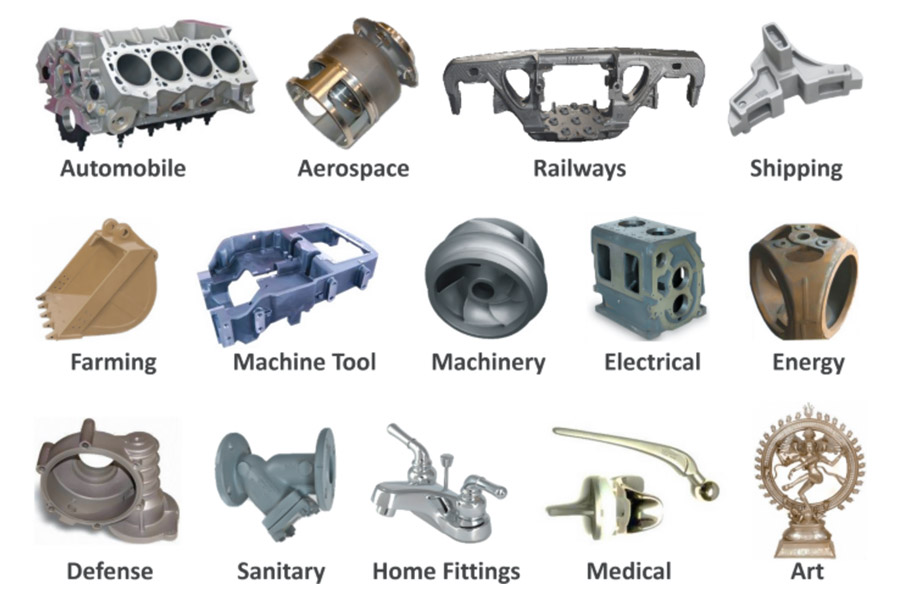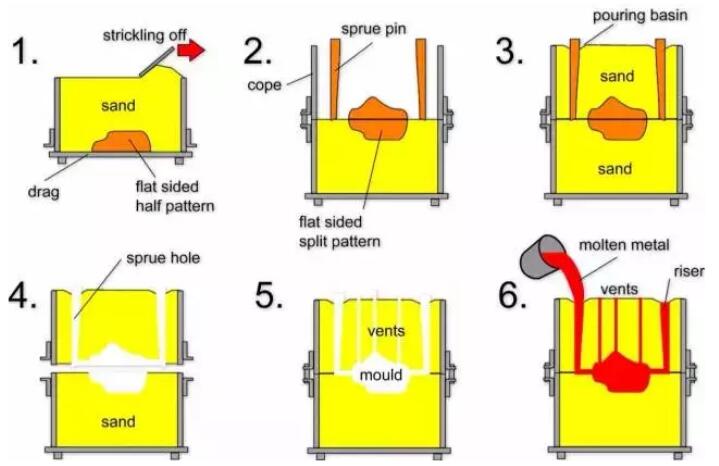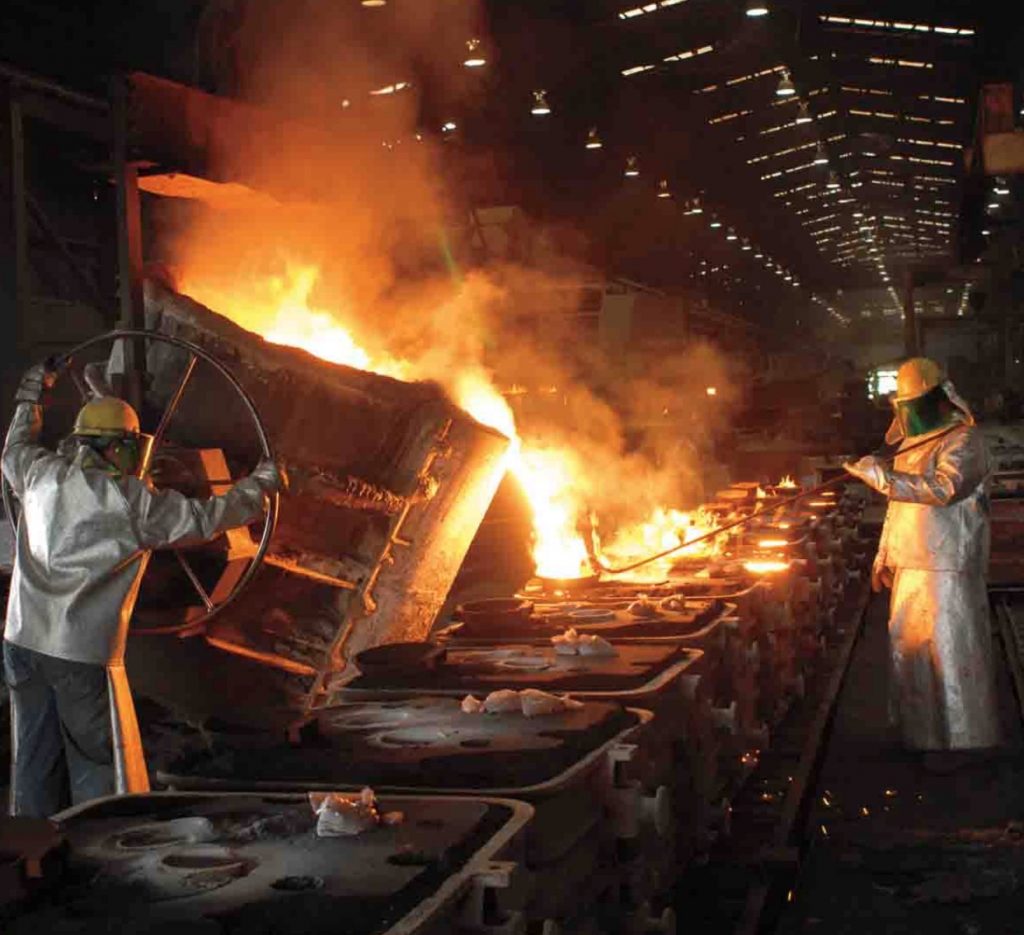A guide into Aluminum Foundry techniques and casting advantages
Recognizing the Metal Castings Refine: A Comprehensive Overview for Beginners
The Metal Casting process is a basic strategy in producing that changes molten steel into strong kinds. Beginners must comprehend the various methods included, such as sand casting and pass away casting. Recognizing the materials, layout principles, and safety actions is similarly crucial. Each facet plays an essential duty in achieving effective end results. As one browses these details, the concern of just how to optimize each action for boosted results comes to be significantly significant.
The Basics of Steel Casting
Although Metal Casting has actually evolved over centuries, its basic principles remain integral and constant to the manufacturing process. At its core, Metal Casting entails the change of molten metal right into solid objects with numerous strategies. The process starts with the creation of a mold, which specifies the form of the final item. As soon as the mold and mildew is prepared, metal is heated up to its melting factor and put into the dental caries. After cooling down, the steel solidifies, taking the shape of the mold and mildew.
There are several casting approaches, including sand spreading, financial investment spreading, and pass away spreading, each with distinct advantages and applications. The option of strategy depends on variables such as production volume, product kind, and wanted accuracy. As soon as cast, the end product may undertake added procedures like machining or surface therapy to attain the required finish and specs. Understanding these essentials is important for anyone interested in the field of Metal Casting.

Understanding Materials Utilized in Steel Casting
Materials play a vital role in the Metal Casting procedure, influencing the last product's buildings and performance. Numerous steels are utilized, including light weight aluminum, bronze, iron, and steel, each offering unique characteristics fit for certain applications. Aluminum is corrosion-resistant and light-weight, making it excellent for vehicle components. Iron, particularly cast iron, is favored for its superb wear resistance and toughness. Steel provides high toughness and convenience, usually used in hefty machinery components. Bronze, known for its corrosion resistance and machinability, is generally employed in marine applications.
In addition to the steels, numerous casting products, such as sand, plaster, and ceramic, are used to create mold and mildews. Sand spreading, the most widespread method, makes use of silica sand due to its thermal stability and ability to develop complex shapes. Plaster and ceramic molds offer better information however may require even more complicated procedures. The selection of products straight influences the effectiveness, expense, and high quality of the casting procedure.
The Layout Refine: From Idea to Blueprint
The design procedure in Metal Casting starts with the initial idea development, where concepts are generated and evaluated. This is adhered to by the application of CAD modeling strategies, enabling exact visualizations of the layout. Ultimately, the blueprint finalization actions ensure that all requirements are properly documented for production.
First Principle Development
First idea growth marks a vital phase in the Metal Casting process, where concepts transform right into concrete designs. Throughout this phase, designers work together with stakeholders and engineers to brainstorm and improve initial concepts. They take into consideration aspects such as functionality, visual appeals, and manufacturability, ensuring that the style fulfills the required requirements and performance standards. Illustrations and outlines are created to picture the concepts, permitting initial evaluations of usefulness and cost-effectiveness. This phase also entails determining products and possible spreading methods that align with the layout goals. Ultimately, first concept development prepares for a complete blueprint, directing the subsequent phases of the casting process and making sure an effective shift from idea to reality.
CAD Modeling Techniques
Changing principles into exact designs, CAD modeling strategies play a critical function in the Metal Casting procedure. These strategies use innovative software application to develop in-depth three-dimensional models that properly reflect the designated item. By utilizing tools such as parametric modeling, strong modeling, and surface area modeling, developers can control dimensions and forms with ease. CAD systems also help with simulation and analysis, allowing for the identification of possible defects before production starts. This positive technique reduces product waste and enhances the style for manufacturability. In addition, CAD models can be conveniently modified, making it possible for fast versions based upon responses. Basically, CAD modeling offers as the foundation of the style process, bridging the gap in between initial concepts and the eventual production-ready styles.
Blueprint Finalization Tips
Complying with the development of comprehensive CAD designs, the next stage includes blueprint completion, which is crucial in translating electronic styles into actionable plans for production. This process starts with reviewing the CAD versions for precision and compliance with requirements. When verified, the measurements, tolerances, and product requirements are thoroughly detailed to guarantee clarity. Including notes and comments assists communicate essential details concerning spreading processes, surface area coatings, and assembly needs. The finalized plan undertakes a rigorous authorization procedure, typically involving collaboration with engineers and manufacturing teams to address any possible issues. Modifications are made and approvals acquired, the plan is formally launched, serving as the foundational paper for the succeeding stages of Metal Casting, consisting of pattern making and mold style.
The Metal Casting Techniques Clarified

Metal Casting techniques incorporate a range of methods made use of to form molten steel into desired types. These methods vary according to the kind of material, intricacy of the style, and manufacturing quantity. Sand casting is among the most usual methods, involving the creation of a mold and mildew from sand to hold the molten steel. Financial investment casting, or lost-wax spreading, permits detailed styles by utilizing a wax pattern that is dissolved. Die casting utilizes high-pressure injection of molten metal right into a mold, ideal for mass production. Other methods include irreversible mold spreading, which uses recyclable molds, and centrifugal spreading, where rotational forces help in loading the mold. wikipedia reference Each method has its applications and benefits, making it important for manufacturers to pick the proper method based upon their specific needs and demands. Recognizing these strategies is vital for anybody entailed in the Metal Casting process.
Ending Up Processes: Enhancing Your Casted Product

Ending up procedures play a vital duty in boosting the high quality and look of casted items. Various surface treatment techniques, such as polishing and finish, are utilized to improve resilience and looks. Additionally, quality assessment techniques ensure that the final product fulfills specified requirements and performance needs.
Surface Area Therapy Methods
A variety of surface area therapy strategies play a vital function in improving the top quality and durability of casted products. These strategies consist of approaches such as shot blasting, polishing, and covering. Shot blowing up efficiently resource gets rid of surface flaws, boosting the visual and useful attributes of the spreading. Polishing supplies a smooth finish, which is particularly essential for ornamental applications and parts requiring marginal friction. Coating strategies, such as electroplating or powder coating, offer additional security versus deterioration and wear, making sure sturdiness. Surface therapies can enhance adhesion for subsequent procedures, such as painting or bonding. By using these techniques, manufacturers can accomplish exceptional surface area top quality, which is crucial for the efficiency and life-span of Metal Casting in various applications.
Top Quality Examination Approaches
Reliable quality inspection approaches are necessary for guaranteeing the stability and efficiency of casted items after the finishing procedures. Numerous techniques are utilized to assess the top quality of Metal Casting, consisting of aesthetic inspection, dimensional checks, and non-destructive testing (NDT) Aesthetic inspection allows for the recognition of surface defects, while dimensional checks guarantee that items satisfy specified tolerances. NDT approaches, such as ultrasonic testing and radiographic assessment, give deeper insights into interior honesty without harming the spreadings. Additionally, mechanical testing, such as tensile and firmness examinations, assesses material homes - Aluminum Foundry. By using a combination of these approaches, makers can boost product high quality and reliability, eventually leading to greater customer fulfillment and minimized manufacturing expenses
Safety And Security Considerations in Metal Casting
While the Metal Casting procedure supplies countless benefits, it additionally presents a variety of safety threats that must be carefully handled. Employees in casting centers are revealed to heats, liquified steels, and harmful products, which can result in extreme injuries if proper safety measures are not taken. Individual protective equipment (PPE) such as heat-resistant handwear covers, deal with shields, and safety clothing is crucial to minimize risks.
Furthermore, the visibility of fumes and dust demands correct ventilation systems to ensure air high quality - Metal Castings. Routine training on safety and security protocols is crucial for all employees to acknowledge prospective hazards and react successfully. Emergency procedures must be developed, consisting of fire precaution and very first help accessibility. Upkeep of tools and correct handling of products better contribute to a much safer working atmosphere. By prioritizing these safety and security factors to consider, Metal Casting operations can shield their workforce and maintain effective production processes
Often Asked Questions
What Are the Environmental Influences of Metal Casting?
Metal Casting can result in environmental impacts such as air and water pollution, resource depletion, and energy consumption. Additionally, improper waste administration and exhausts from shops contribute to eco-friendly disturbances and wellness risks for nearby communities.
How Do I Pick the Right Steel for Casting?
To choose the best steel for spreading, one must take into consideration aspects such as mechanical properties, corrosion resistance, thermal conductivity, and price. Reviewing the designated application and ecological conditions is necessary for perfect option.
What Are the Usual Problems in Metal Casting?
Usual problems in Metal Casting include porosity, shrinking, sand incorporation, and misruns. These problems often arise from incorrect material option, inadequate design, or problems in the spreading process, influencing the last product's top quality and efficiency.
How Can I Enhance My Steel Casting Abilities?
To boost Metal Casting skills, one should practice regularly, research spreading strategies, analyze previous projects for defects, seek comments from experienced wheels, and continuously experiment with different products and methods to improve proficiency and understanding.
What Is the Price of Starting a Metal Spreading Company?
Beginning a metal casting company normally calls for an initial investment of $5,000 to $50,000, depending upon equipment, materials, and center prices. Factors like location and scale can substantially affect total startup expenses.
The Metal Casting process is an essential method in producing that transforms molten steel into strong kinds. Newbies need to comprehend the different methods involved, such as sand spreading and die casting. There are a number of casting techniques, including sand spreading, financial investment casting, and pass away casting, each with special additional hints advantages and applications. Investment spreading, or lost-wax casting, permits for complex layouts by using a wax pattern that is thawed away. Other approaches consist of irreversible mold casting, which makes use of reusable mold and mildews, and centrifugal spreading, where rotational forces help in loading the mold.